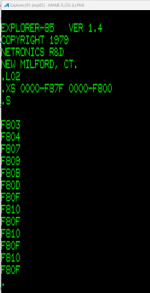daver2
10k Member
There is a set/reset latch formed out of U108 and U115 generating the signal /BOOT ACTIVE. This signal is set active (LOW) on a reset.
The above signal is fed into U107.
When the CPU outputs an address in the range $Fxxx OR the /BOOT ACTIVE signal is active, then the MONITOR ROM inside U105 is activated.
I suspect that the signal /MONITOR CS should really be MONITOR CS.
Basically, on a reset, the monitor ROM will respond to addresses $0xxx, $1xxx, ... , $Fxxx.
Once the monitor ROM is running (say following a reset) the latch can be 'flipped' and the monitor ROM will now only respond to addresses in the range $Fxxx. I can't remember now (off the top of my head) how you flip the latch. You probably read from (or write to) a specific I/O port address.
EDIT: The logic for flipping the latch is a little more convoluted than I first remembered... It may take me a little longer to find the relevant information again, so I will leave that as an exercise for the reader!
Dave
The above signal is fed into U107.
When the CPU outputs an address in the range $Fxxx OR the /BOOT ACTIVE signal is active, then the MONITOR ROM inside U105 is activated.
I suspect that the signal /MONITOR CS should really be MONITOR CS.
Basically, on a reset, the monitor ROM will respond to addresses $0xxx, $1xxx, ... , $Fxxx.
Once the monitor ROM is running (say following a reset) the latch can be 'flipped' and the monitor ROM will now only respond to addresses in the range $Fxxx. I can't remember now (off the top of my head) how you flip the latch. You probably read from (or write to) a specific I/O port address.
EDIT: The logic for flipping the latch is a little more convoluted than I first remembered... It may take me a little longer to find the relevant information again, so I will leave that as an exercise for the reader!
Dave
Last edited:


